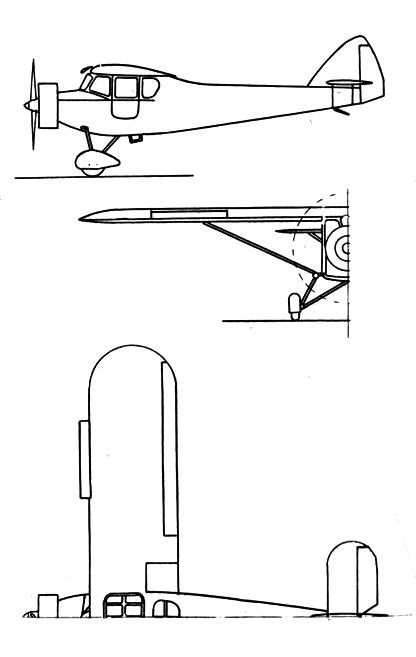Potez 43 on:
[Wikipedia]
[Google]
[Amazon]
The Potez 43 was a family of French light utility and sports aircraft, developed in early 1930s. They were three-seat single-engine high-wing
 Mixed construction
Mixed construction
Photos and drawing at Ugolok Neba page
{{Potez aircraft 1930s French civil utility aircraft 043 High-wing aircraft Single-engined tractor aircraft Aircraft first flown in 1932
monoplane
A monoplane is a fixed-wing aircraft configuration with a single mainplane, in contrast to a biplane or other types of multiplanes, which have multiple planes.
A monoplane has inherently the highest efficiency and lowest drag of any wing con ...
s.
Design and development
The plane was a development ofPotez 36
The Potez 36 was a French two-seat touring or sport monoplane designed and built by Potez. The Potez 36 was a high-wing braced monoplane with a conventional landing gear. It had an enclosed cabin with side-by-side seating for a pilot and passenger ...
. First of all it featured new, slimmer fuselage, with three seats, instead of two. A disadvantage were non-folding wings, with shorter slats
Super Low Altitude Test Satellite (SLATS) or Tsubame was a JAXA satellite intended to demonstrate operations in very low Earth orbit (VLEO, below 200 km), using ion engines to counteract aerodynamic drag from the Earth's atmosphere which i ...
. The original Potez 430 first flew in June 1932, powered by a Potez 6Ас radial engine. 25 examples of this variant were completed, followed by other variants, differing with the last digit in designation. Other variants built in significant numbers were Potez 431 and Potez 438. 161 of Potez 43 family were built in total.
Operational service
Two Potez 430s (registrations: F-AMBM and F-AMBN) took part in theChallenge 1932 The Challenge 1932 was the third FAI International Tourist Plane Competition (french: Challenge International de Tourisme), that took place between 12 and August 28, 1932 in Berlin, Germany. The four Challenges, from 1929 to 1934, were major aviat ...
international tourist plane contest. Pierre Duroyon took the 22nd place (for 43 starting and 24 finishing crews), while Georges Detre was disqualified due to low cruise speed.
Variants
;Potez 430 :First version, Potez 6Ас engine, 25 built. ;Potez 431 :Modified series version of 1933, Potez 6Ас engine, 60 built. ;Potez 432 :Version withRenault 4Pei
The Renault 4P, also called the Renault Bengali Junior, was a series of air-cooled 4-cylinder inverted inline aero engines designed and built in France from 1927, which produced from to .
Design and development
Charles Lindbergh's Atlantic Ocea ...
engine, 3 built (first flew 21 April 1933).
;Potez 434
:Version with de Havilland Gipsy Major I
The de Havilland Gipsy Major or Gipsy IIIA is a four-cylinder, air-cooled, inverted inline engine used in a variety of light aircraft produced in the 1930s, including the famous Tiger Moth biplane. Many Gipsy Major engines still power vinta ...
straight engine, 9 built (first flew 2 November 1933).
;Potez 435
:Version with Renault 4Pdi
The Renault 4P, also called the Renault Bengali Junior, was a series of air-cooled 4-cylinder inverted inline aero engines designed and built in France from 1927, which produced from to .
Design and development
Charles Lindbergh's Atlantic Ocea ...
engine, 11 built (first flew 23 June 1933).
;Potez 436
;Potez 437
:Modified version with Renault 4Pdi
The Renault 4P, also called the Renault Bengali Junior, was a series of air-cooled 4-cylinder inverted inline aero engines designed and built in France from 1927, which produced from to .
Design and development
Charles Lindbergh's Atlantic Ocea ...
engine, 9 built (first flew 17 July 1934).
;Potez 438
:Military trainer and liaison version with Renault 4Pdi
The Renault 4P, also called the Renault Bengali Junior, was a series of air-cooled 4-cylinder inverted inline aero engines designed and built in France from 1927, which produced from to .
Design and development
Charles Lindbergh's Atlantic Ocea ...
engine and a tail wheel, of 1934. 40 built (according to other sources, 33).
;Potez 439
Operators
; * French Air ForceSpecifications (Potez 430)
 Mixed construction
Mixed construction strut
A strut is a structural component commonly found in engineering, aeronautics, architecture and anatomy. Struts generally work by resisting longitudinal compression, but they may also serve in tension.
Human anatomy
Part of the functionality o ...
ted high-wing monoplane
A monoplane is a fixed-wing aircraft configuration with a single mainplane, in contrast to a biplane or other types of multiplanes, which have multiple planes.
A monoplane has inherently the highest efficiency and lowest drag of any wing con ...
. A steel framed fuselage covered with canvas. Rectangular two-spar wing, with rounded ends, of wooden construction, canvas covered. Wings were equipped with slats
Super Low Altitude Test Satellite (SLATS) or Tsubame was a JAXA satellite intended to demonstrate operations in very low Earth orbit (VLEO, below 200 km), using ion engines to counteract aerodynamic drag from the Earth's atmosphere which i ...
on 1/3 span and supported with main V-shaped struts. Closed cabin with three seats, well glazed. Engine in front, two-blade propeller. Conventional fixed landing gear
Landing gear is the undercarriage of an aircraft or spacecraft that is used for takeoff or landing. For aircraft it is generally needed for both. It was also formerly called ''alighting gear'' by some manufacturers, such as the Glenn L. Martin ...
, with a rear skid, wheels in teardrop covers.
See also
References
Bibliography
*Further reading
*External links
Photos and drawing at Ugolok Neba page
{{Potez aircraft 1930s French civil utility aircraft 043 High-wing aircraft Single-engined tractor aircraft Aircraft first flown in 1932